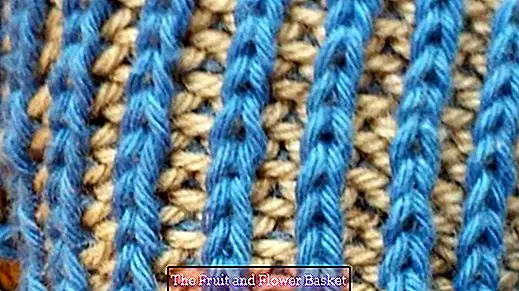Knitting pattern - two-tone half-patent
Two-tone semi-patent: If you want to process wool remnants, also different quality, then two-tone half-patent is suitable. Here is an example of a beige and blue patent sample.
The blue thread is a cotton yarn, the beige thread is new wool. I knitted with needle size 4, according to the label needle size 2.5 to 3.5 was recommended for both threads.
For a two-tone half-patent, the right-hand stitches in the main color (blue) dominate on the front of the knit, and the left-hand stitches in between are available in both colors (beige / blue). Figures 1, 2, 7, 8, 9, and 10 show the front of the work.
On the back, both colors look equally strong. The right stitches are knitted alternately in one color or the other, the left ones only in the main color. Figures 3, 4, 5 and 6 show the back of the work.
This effect comes about:
In the secondary color (beige) only knit every other stitch, right or left, as it appears and lift the stitches with an envelope between them, also on the right or on the left, as they appear. In the rows (you see the front side of the work) take off the right stitches, knit the left one, knit the right stitches in the back rows, lift off the left stitches.
IKnit all stitches in the main color (blue) in each rowOn the right or left, as they appear, knit the envelope that knits over every other stitch.
You can knit two-tone half-patents in back and forth rows or in rounds. Here is a detailed explanation:
Two-tone half-patent knitted in back and forth rows:
One knits alternately a row in each color. That's why you always have to knit two rows and then two back rows alternately. This is only possible with a circular needles or knitting needles from a double pointed needles.
You knit a few rows on the right in the ribbed pattern in the main color (blue).
- Hinreihe in the secondary color (picture 7): Both threads hang on the right edge of the back row. Knit the edge stitch with both colors (blue + beige), then knit the row in the secondary color (beige), taking off the stitches on the right with the envelope on the left, knit the left stitches on the left, lift off the last stitch (edge stitch) hangs on the left edge of the back row, the thread of the main color hangs on the right edge of the back row, push all stitches for the second row to the right (picture 8).
- Row in the main color (picture 9): Take off the edge stitch (already knit in both colors), then knit all the stitches as they appear, knit the envelope in the secondary color with the right stitches (Fig. 9). Lift off the last stitch (edge stitch). Both threads are now hanging on the left edge of the back row. Turn the knitting and knit the first back row.
- Back row in the secondary color (Figures 4 and 5): Knit the edge stitch with both threads (blue + beige) (see picture 4), then knit the back row in the secondary color (beige), taking off the left stitches with the envelope on the left (picture 5), knit the right stitches on the right. Lift off the last stitch (edge stitch). The thread of the secondary color hangs on the left edge of the back row, the thread of the main color hangs on the right edge of the back row. Move all stitches for the second back row to the right.
- Back row in the main color (Figure 6): Take off the edge stitch (already knit in both colors), then knit all the stitches in the main color as they appear, at the left stitches knit the envelope in the secondary color with the left. Lift off the last stitch (edge stitch).
Repeat these four rows continuously.
Finally, knit a few rows in the main color right-left ribbed.
Two-tone half-patent knitted in rounds:
For example, for pulse warmer with double needle play or for a loop scarf on a circular needle.
Most knitters can knit right stitches faster than left knits, so I recommend keeping the knit with the back outside and the front inside. First knit a few rounds in the ribbed pattern on the right side. Then you knit the rounds 3 and 4 described above alternately. For a better color change and to mark the color change you can knit the first stitch of each round with both threads on the right.
- Round in the secondary color: Knit the first stitch loosely with both threads (blue + beige) on the right, then knit the round in the secondary color (beige), taking off the left stitches with the envelope on the left, knit the right stitches on the right.
- Round in the main color: Unfasten the first stitch without an envelope (already knit in both colors), then knit all the stitches in the main color as they appear, at the left stitches, knit the envelope in the secondary color on the left.
Two-tone half-patent is suitable for scarves or wrist warmers. On the last picture you can see wrist warmers in a two-tone half-patent. The first one I knitted in rounds, at the thumb hole you have to work in roundtrip instead of rounds. The second wrist warmers I knitted in back and forth rows and then sewn together to the thumb hole.
I like the result of the first pulse heater better.He looks good from both sides. Knitting in back and forth rows is more complicated, you really only need it for the piece around the thumb hole and for scarves.
Because of the different thread quality, I will wash the wrist warmers only with lukewarm water by hand and make sure that there is no temperature difference between wash water and rinse water.





